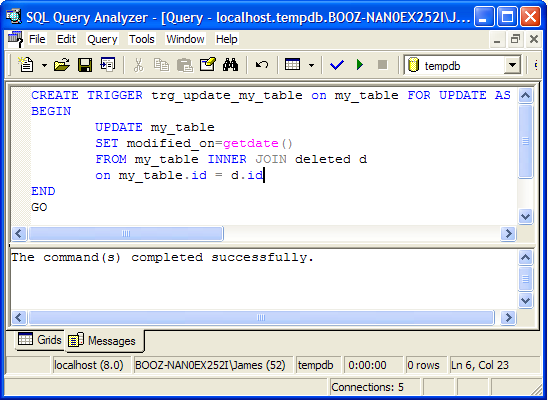
Introduction
This article explains how to add a Modified On column to a table. SQL Server does not support this natively, and the misleading Timestamp field type does not do what we want. Our solution will be implemented entirely in SQL Server so that we don’t have to change the existing code or worry about writing the current date on every update.
Background
In SQL Server, triggers are used to execute SQL commands on an update, delete, or insert to a specific table. For more information, look at http://msdn.microsoft.com/msdnmag/issues/03/12/DataPoints/.
Using the code
Shown below is a simple table that has a column to store data:
CREATE TABLE [my_table] (
[id] [int] IDENTITY (1, 1) NOT NULL,
[my_data] [nvarchar] (50) NULL,
[created_on] [datetime] NOT NULL,
[modified_on] [datetime] NOT NULL,
) ON [PRIMARY]
ALTER TABLE [my_table] WITH NOCHECK ADD
CONSTRAINT [PK_my_table] PRIMARY KEY CLUSTERED ( [Id] ) ON [PRIMARY]
GO
ALTER TABLE [my_table] ADD
CONSTRAINT [DF_my_table_created_on] DEFAULT (getdate()) FOR [created_on]
GO
ALTER TABLE [my_table] ADD
CONSTRAINT [DF_my_table_modified_on] DEFAULT (getdate()) FOR [modified_on]
GO
The method getdate() returns the current date-time. created_on and modified_on are automatically set to getdate() when a row is inserted.
Creating the trigger
Our trigger is fairly simple:
CREATE TRIGGER trg_update_my_table on my_table FOR UPDATE AS
BEGIN
UPDATE my_table
SET modified_on=getdate()
FROM my_table INNER JOIN deleted d
on my_table.id = d.id
END
GO
SQL Server maintains two meta-tables for each transaction, inserted and deleted. deleted records the old rows, and inserted records the new rows. In our case, it doesn’t matter which we use. Keep in mind that multiple, or zero, rows can be updated on a single command. Using a join will handle those cases. The great part about using a trigger is modified_on will always be set; the trigger will run even if the updates come from, for instance, another trigger.
Allow overwriting of modified_on
The trigger overwrites any changes made to modified_on. I think this is a good thing, but you could stop any overwrites by creating the trigger as:
CREATE TRIGGER trg_update_my_table on my_table FOR UPDATE AS
BEGIN
if not update(modified_on)
begin
UPDATE my_table
SET modified_on=getdate()
FROM my_table INNER JOIN deleted d
on my_table.id = d.id
end
END
GO
The update() function returns true if the specified the column was modified.
Disallow overwriting of created_on
You could also stop a command from accidently overwriting created_on by creating the trigger as:
CREATE TRIGGER trg_update_my_table on my_table FOR UPDATE AS
BEGIN
UPDATE my_table
SET modified_on=getdate(), created_on=d.created_on
FROM my_table INNER JOIN deleted d
on my_table.id = d.id
END
GO
This sets created_on to be the value of the row before it was updated.
